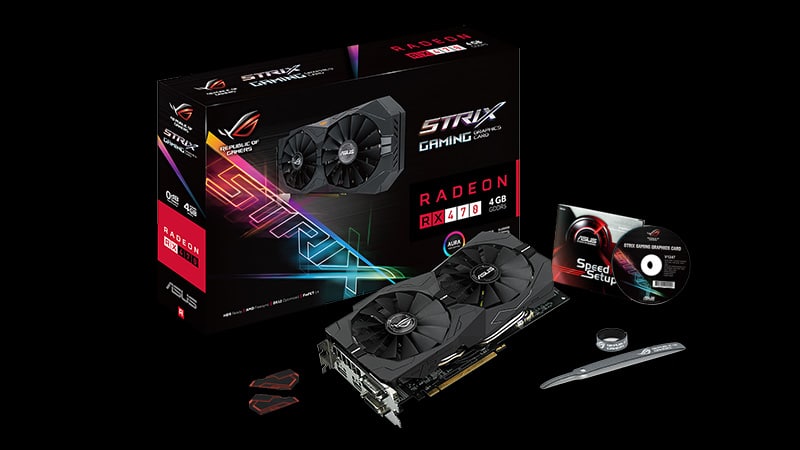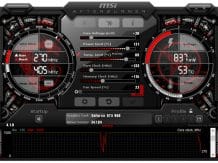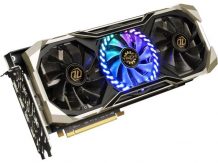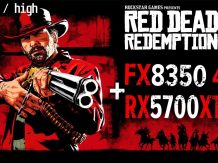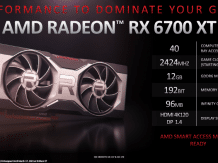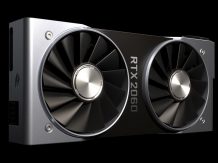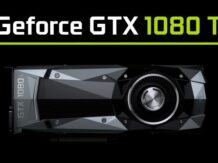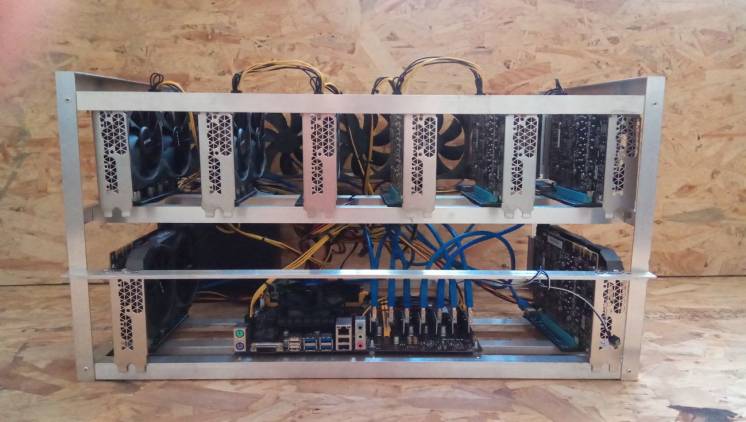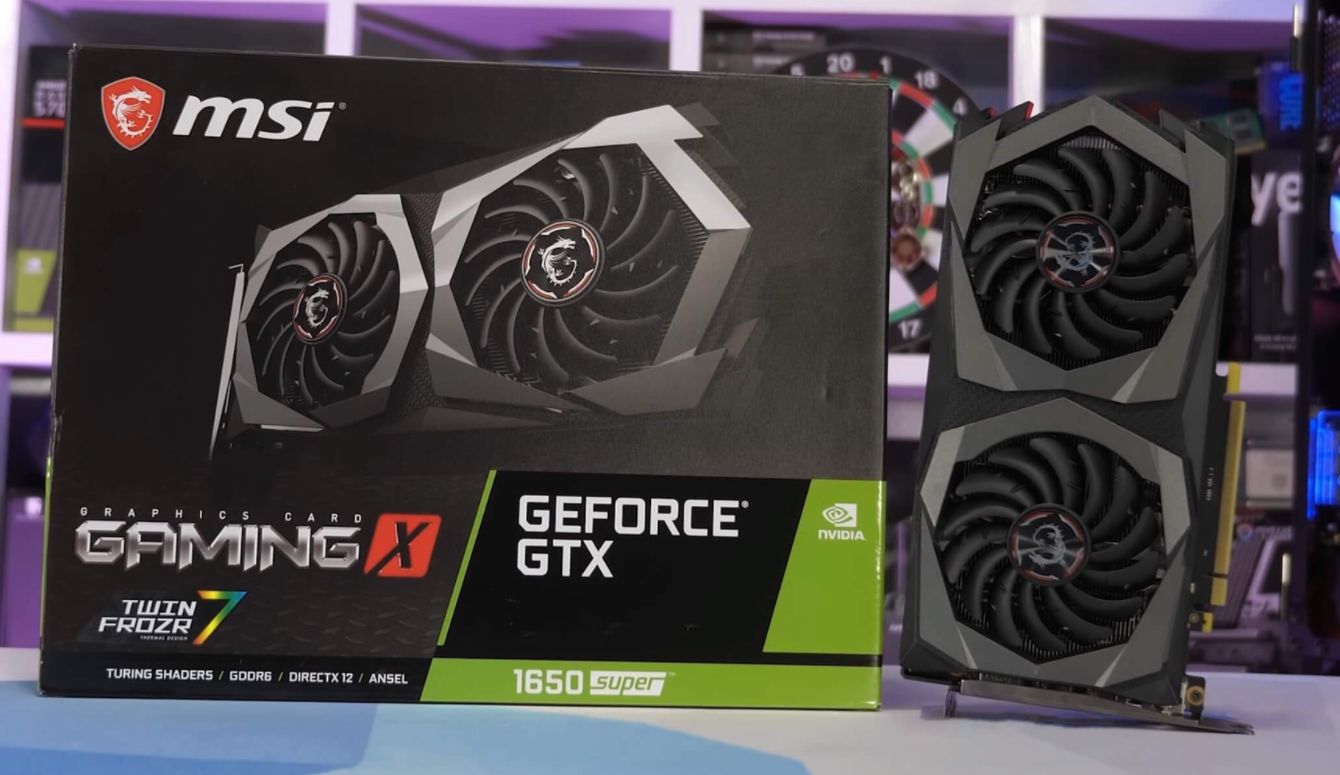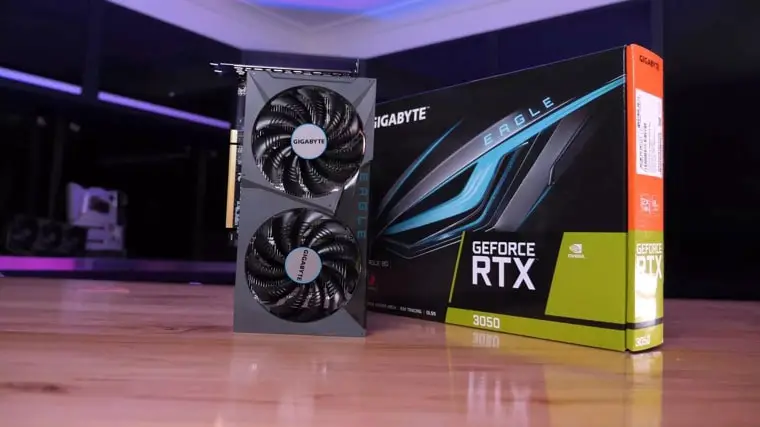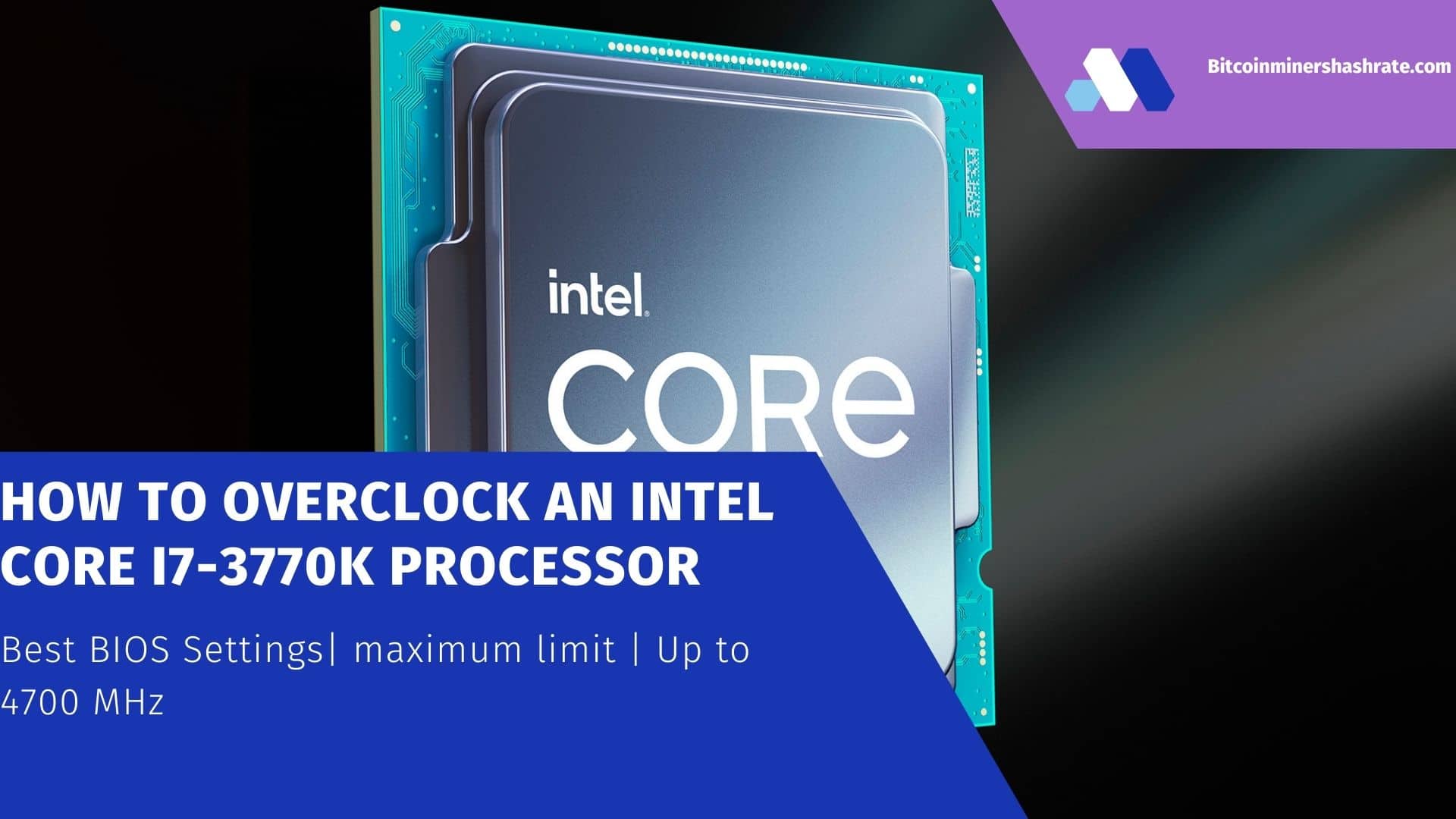How To ‘Increase/ Max/ Optimize’ ASUS ROG Strix RX 470 4GB Mining: Overclocking | Hashrate | BIOS | MSI Afterburner | Best Settings | Dual mining – Good afternoon, we present to your attention a guide on how to achieve performance of 29-30 MH / s for the Ethash algorithm (Dagger-Hashimoto) on a Sapphire RX 478 8GB Mining Edition (ME ) with Samsung memory . This is the first such material on our website and in the future, if possible, we will try to write similar guides for other popular video cards for mining.
This article will be useful to you if you have problems with setting up your GPU Sapphire RX 478 8GB Mining Edition (ME) and you have not been able to achieve the maximum hash rate at which this video card can work. We have prepared this material for you with all the necessary instructions for setting up the GPU in the maximum hash rate mode. This took us a lot of time, trial and error. This article will allow you to use our experience and now you do not have to “reinvent the wheel”.
The trick is to find the correct BIOS version and spice it up with the correct frequencies. We managed to achieve consistent high hash rates in all 4 tested samples of Sapphire RX 478 8GB Mining Edition (ME), which still have stable hash rates and power consumption.
Before we get into the tutorial itself, I’d like to mention that the Sapphire RX 470 8GB ME has a kind of design issue that makes it difficult to set up for mining. Since many people seem to be facing the same problems, we decided to start this guide by solving similar problems. Like us, you may encounter one or more problems in the process, so we thought it would be a good idea to inform you about possible potential problems that you may encounter and provide you with adequate solutions.
Note: The samples of Sapphire RX 478 8GB Mining Edition (ME) graphics cards we are using have Samsung memory, this BIOS will not work with GPUs that use Hynix memory.
Having dealt with the shortage of Polaris 10 GPUs, AMD was finally able to provide its partners with chips, and the original versions of the Radeon RX 480 and Radeon RX 470 have flooded the market for two months now. The choice of interesting models of these video cards is already quite wide, and we will gradually try to introduce you to most of them, especially since the next AMD graphics processors in the middle class of video cards will have to wait for a long time.
The first in line will be the ASUS ROG Strix RX 470 OC model, which has already been in our tests, but left more questions than answers.
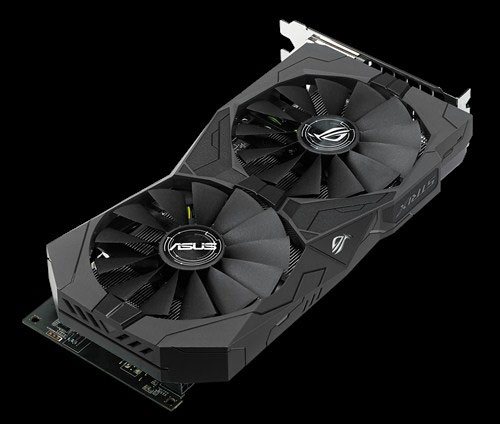
And the most important of them: did ASUS and AMD programmers manage to fix the situation with lowering the frequencies of the GPU in 3D mode? In addition, today we will test the video card with the penultimate drivers and new games. Unfortunately, the direct competitor in the face of the GeForce GTX 1060 with 3 GB of memory is not yet available for testing, but the six-gigabyte version has already come close to the Radeon RX 470 4 GB in cost, and the RX 470 versions with 8 GB of memory are even slightly more expensive. …
Specifications and recommended cost
The technical characteristics and cost of the ASUS ROG Strix RX 470 OC video card are shown in the table in comparison with the performance of the reference versions AMD Radeon RX 480 and AMD Radeon RX 470, where the key differences are highlighted in bold.
| Name of technical characteristics | AMD Radeon RX 480 | AMD Radeon RX 470 | ASUS ROG Strix RX 470 OC | |
| GPU | Polaris 10 XT Ellesmere (TSMC) | Polaris 10 XT Ellesmere (TSMC) | Polaris 10 XT Ellesmere (TSMC) | |
| Process technology, nm | 14 | 14 | 14 | |
| Crystal area, mm2 | 232 | 232 | 232 | |
| Number of transistors, million | 5700 | 5700 | 5700 | |
| GPU frequency, MHz | 3D | 1120 (1266 – boost) | 926 (1206 – boost) | 1250 (1270 – boost) |
| 2D | 367 | 300 | 300 | |
| The number of unified shader processors, pcs. | 2304 | 2048 | 2048 | |
| Number of texture units, pcs. | 144 | 128 | 128 | |
| The number of blocks of raster operations (ROPs), pcs. | 32 | 32 | 32 | |
| Theoretical maximum fill rate, Gpix. / S | 40,5 | 38,6 | 40,6 | |
| Theoretical maximum texture sampling rate, Gtex / s | 182,3 | 154,4 | 162,6 | |
| Supported memory type | GDDR5 | GDDR5 | GDDR5 | |
| Memory bus width, bit | 256 | 256 | 256 | |
| Effective video memory frequency, MHz | 3D | 7 000 / 8 000 | 6 600 | 6 600 |
| 2D | 1 200 | 1 200 | 1 200 | |
| Memory size, GB | 4 / 8 | 4 | 4 | |
| Video memory bandwidth, GB / s | 256,0 | 211,2 | 211,2 | |
| Peak power consumption in 3D operating mode, W | 3D | 150 | 120 | 120 |
| 2D | n / a | n / a | n / a | |
| Power supply requirements, W | 500 | 500 | 500 | |
| Dimensions of the video card, mm (D × H × T) | 244 × 102 × 38 | 244 × 102 × 38 | 242 × 129 × 42 | |
| Weight, g | n / a | n / a | 648 | |
| Interface | PCI-Express x16 (v3.0) | PCI-Express x16 (v3.0) | PCI-Express x16 (v3.0) | |
| Outputs | 1 HDMI v2.0b, 3 DisplayPort v1.4 | 1 HDMI v2.0b, 3 DisplayPort v1.4 | 2 DVI-D, 1 HDMI v2.0b, 1 DisplayPort v1.4 | |
| Minimum retail price *, rub. | 15100 / 17 850 | 12 900 | 14 450 |
* According to Yandex.Market data as of 23.12.2016.
Packaging and packaging
ASUS ROG Strix RX 470 OC comes in a small cardboard box with a graphics card on the front side, as well as the name of the model and series. Nearby are a label mentioning ASUS Aura proprietary lighting and a sticker with bonus premium access to the Diana cruiser in World of Warships.
The reverse side of the box details all the features of the video card, its software and video outputs, and also provides backlighting options.
On one of the ends of the box, you can find a sticker with the video card marking with the serial number, batch number and barcodes.
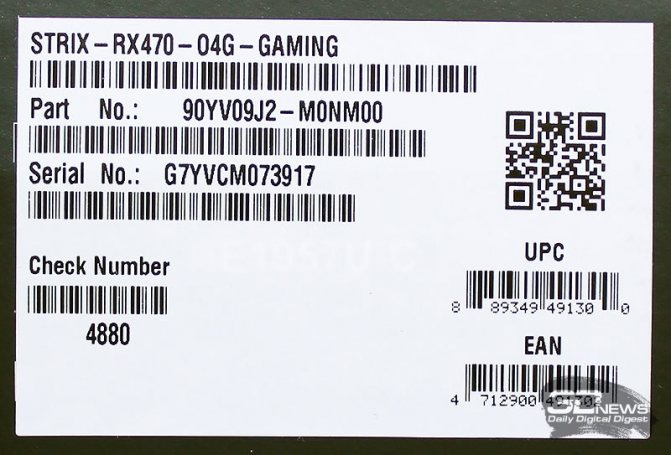
Inside the package, the video card is located in the central compartment and is additionally sealed in an antistatic bag.
The package includes a CD with drivers and utilities, a quick installation guide, a coupon for the game mentioned above, stickers for the cooling system shroud and cable ties.
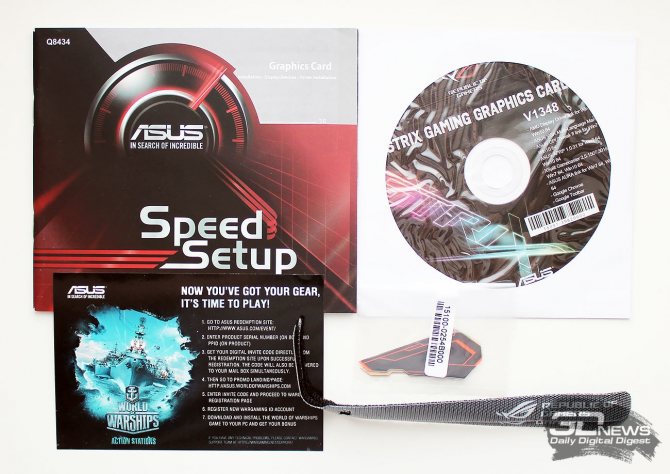
Like most ASUS products, the graphics card is manufactured in China and comes with a three-year warranty. In Russian stores, the price for this model starts at 14,450 rubles, which is no higher than the price level of the original Radeon RX 470 competing companies. But for the eight-gigabyte version of the ASUS ROG Strix RX 470 OC, you will have to pay three thousand rubles more.
BIOS reflashing:
Since this version of the video card has 2 BIOS switches for accessing 4 BIOS versions, we tested all 4 versions. If you use any of these BIOS versions with default settings, you are unlikely to be able to achieve hash rates greater than 27-28 MH / sec on the Dagger-Hashimoto algorithm. If you are interested, you can check it yourself. If you are not satisfied with this result, then you will have to flash the BIOS. We have changed the settings for the energy efficient BIOS. Therefore, before flashing the BIOS, you will have to flip both BIOS switches to the lower position (BIOS # 2) and restart the rig.
- Creating a BIOS backup . Before flashing the BIOS, we recommend that you make a backup copy of it.
- Download modified BIOS versions for Sapphire RX 470 8GB Mining Edition . ,.
- Firmware . Very important!!! Always extract AtiFlash to the ” C: / atiflash ” folder in the same directory, place all the required ROM file. You can see more details about the process in paragraph 5 of this video (in English.)
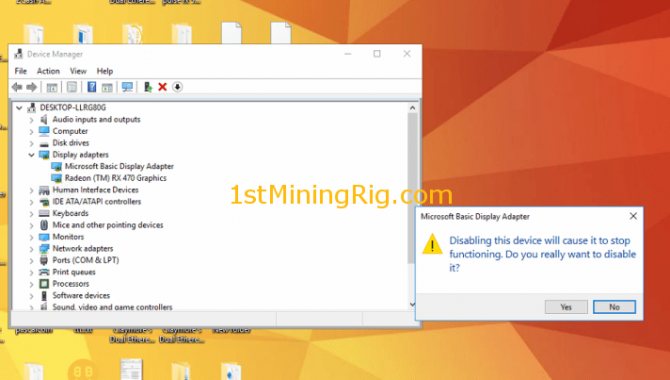
Design and features of the printed circuit board
ASUS ROG Strix RX 470 OC is designed in the general style of the Strix series graphics cards. Its entire front side is covered by a black plastic casing of the cooling system with two large fans, which slightly extends beyond the upper edge of the PCB PCB.
There is no protection on the reverse side, so when installing a video card on a motherboard, you need to be careful, especially if it has to coexist with large-sized processor coolers. Wrong movement – and you can easily lose several elements on the PCB.
The plastic casing of the cooler partially covers the top and bottom of the video card, but part of the heatsink and heat pipes are still visible.
On top of the shroud, there is a backlit ROG logo. The dimensions of the video card are 242 × 129 × 42 mm, and it weighs 648 grams.
ASUS ROG Strix RX 470 OC is equipped with two DVI-D video outputs, one DisplayPort version 1.4 and one HDMI version 2.0b.
For additional power supply, the video card is equipped with one six-pin connector located in the upper part of the casing and conveniently oriented with the latch outward.
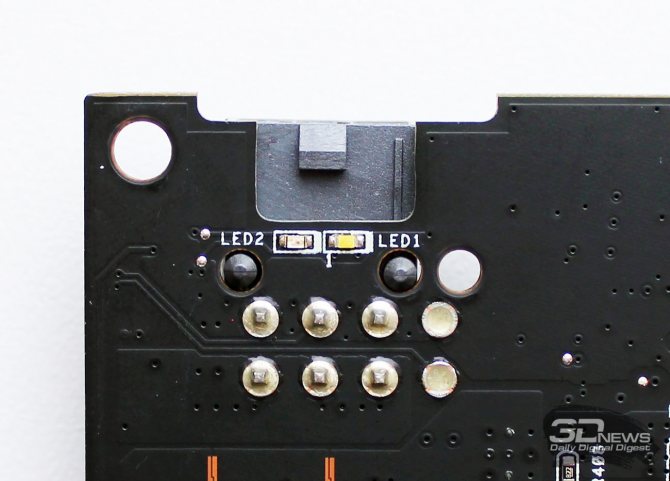
Note that the connector is equipped with two LEDs – white and red. White glows when the power cable is connected, and red indicates a disconnected cable or some kind of power problem. The declared power consumption level of the video card is 120 watts, and the power supply for a system with one such video card must be at least 500 watts.
Four screws are used to secure the cooling system to the PCB around the perimeter of the GPU, so it was not difficult to remove it.
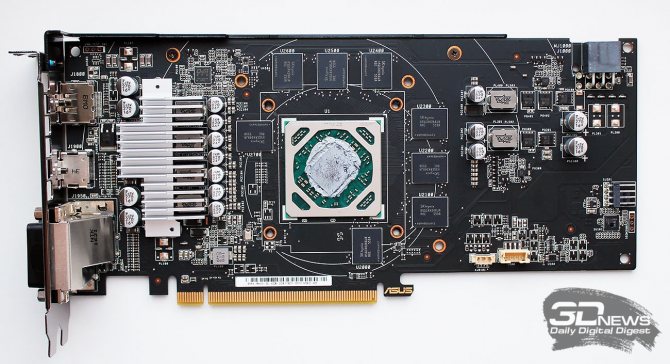
Next, you need to unscrew the stiffener from the upper edge of the PCB and a small aluminum radiator from the power supply circuit of the GPU. The ASUS ROG Strix RX 470 OC board is now completely open to explore.
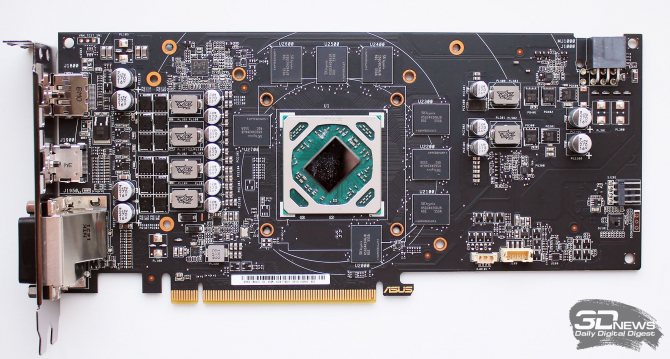
The printed circuit board is manufactured using the proprietary, fully automated ASUS Auto-Extreme technology with constant quality control and the most stringent environmental requirements, such as flux-free production. Minimizing the influence of the human factor in the production of a printed circuit board allows you to increase the level of product quality and increase production volumes.
As for the power section of the board, built using Super Alloy Power II technology, four phases are allocated to power the GPU, which use high-quality Dr. MOS power transistors, economical POSCAP capacitors and silent chokes.
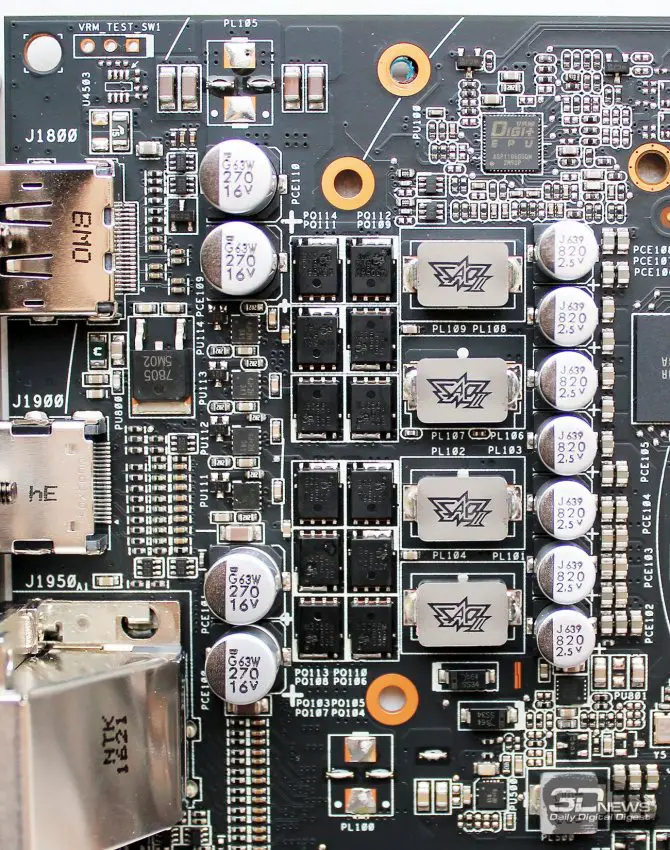
According to the manufacturer, thanks to this set of high-quality components, the temperatures of the power elements are reduced – by a maximum of 20%, the service life is increased to 90 thousand hours, the noise is halved and greater stability during overclocking is achieved.
The board uses a Digi + VRM controller (ASP1106 chip) to control the GPU power.
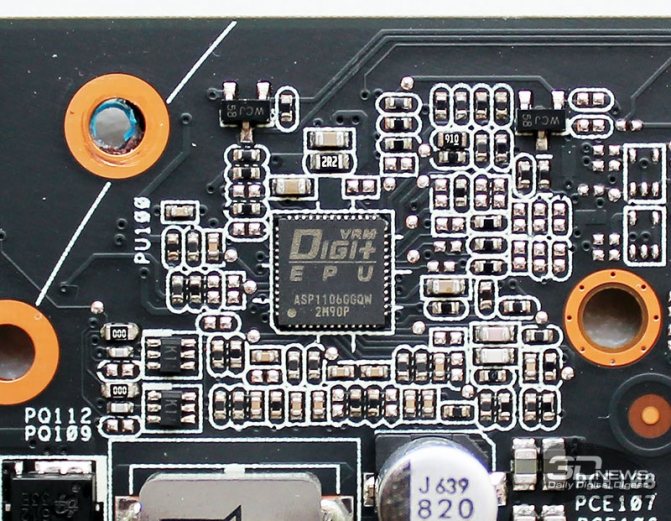
Another phase of the power supply, which consists of the same components as the GPU, is allocated for video memory and power circuits.
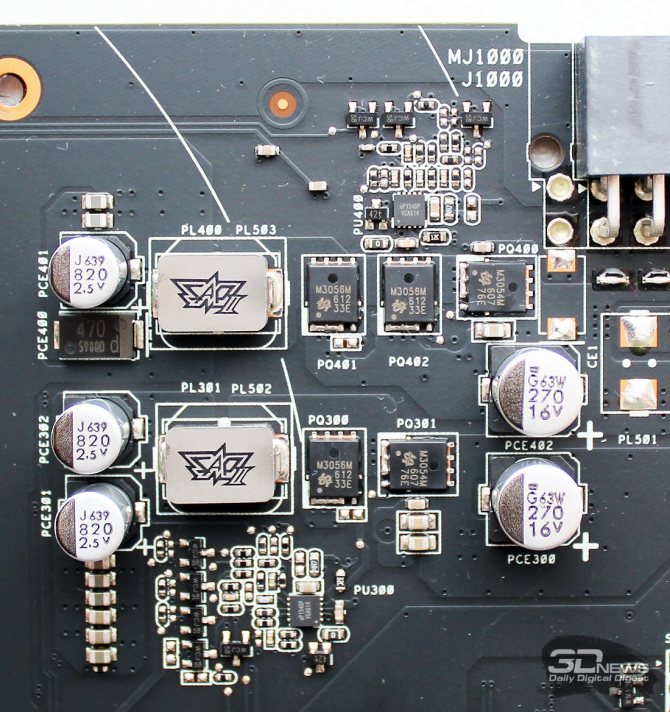
The uP1540P microcircuit is used as a video memory controller.
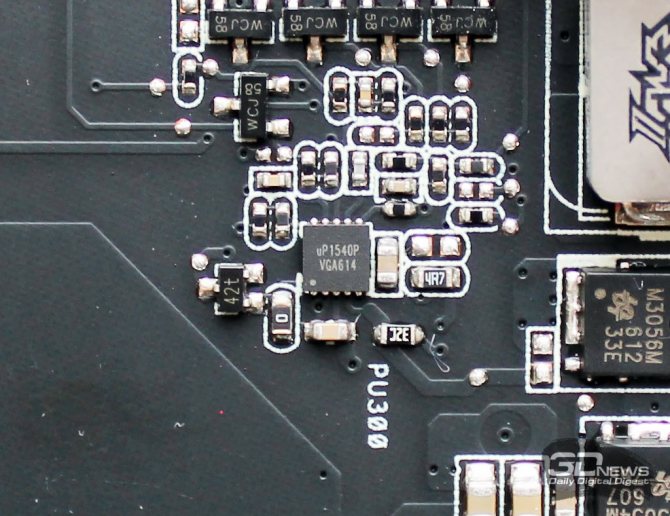
On the right side of the video card, you can see the four-pin ASUS FanConnect connector, designed to connect one case fan directly to the video card.
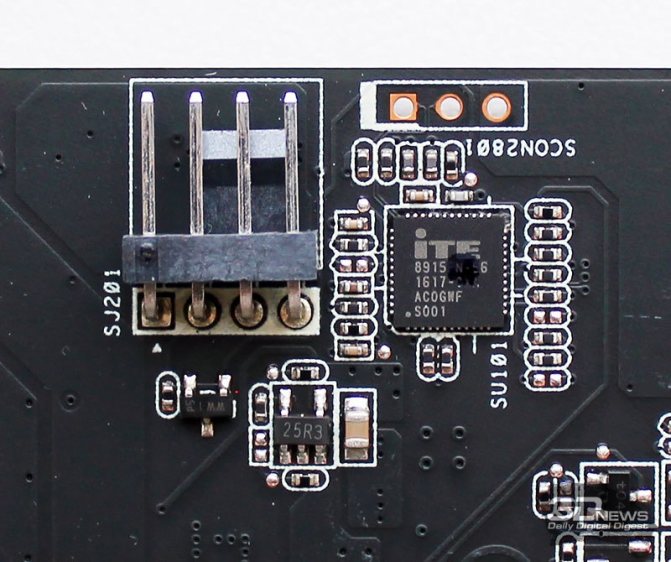
The speed of this fan will be controlled by the video card itself – depending on the temperature of the GPU. You can adjust the dependence of its speed on the heating level of the chip using the ASUS GPU Tweak II utility.
The Polaris 10 GPU of our ASUS ROG Strix RX 470 OC was released according to the 14nm process technology in the 22nd week of 2021 (early June) and has a die area of 232 mm2.
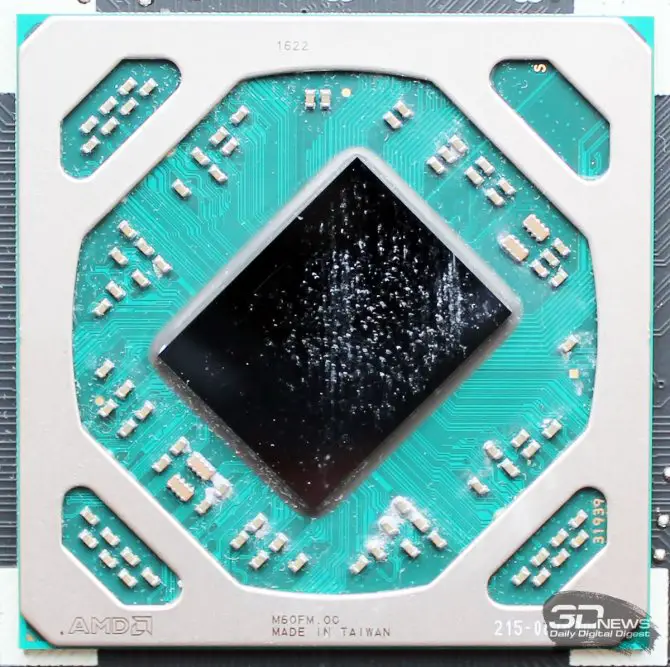
Recall that it contains 2048 unified shader processors, 128 texture units and 32 raster operations (ROP) units. As for the GPU frequency in 3D mode, it is declared at 1250 MHz and 1270 MHz (in OC mode) – this is almost 35% higher than the base frequency of the AMD Radeon RX 470. However, in fact, the video card did not work at such frequencies of the GPU … Details will come a little later.
Our version of ASUS ROG Strix RX 470 OC is equipped with four gigabytes of GDDR5 video memory – this volume is recruited by eight microcircuits soldered on the front side of the PCB. The microcircuits are produced by SKhynix, their marking is H5GC4H24AJR R0C.
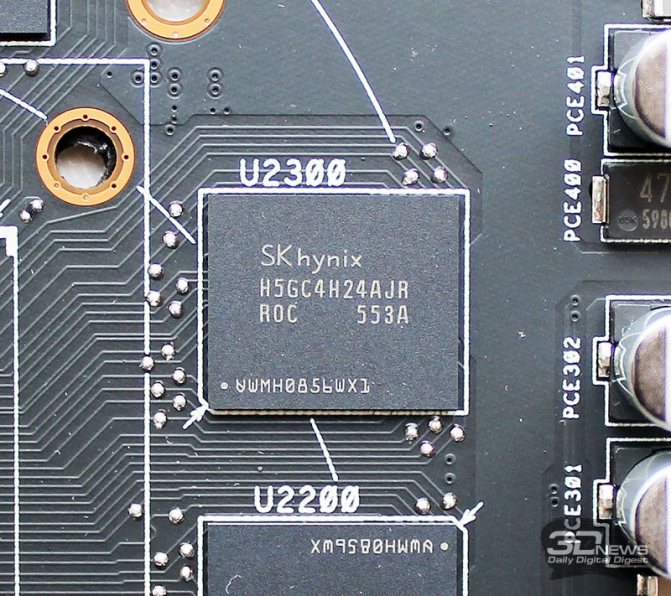
Judging by the marking, the effective frequency of such chips is 6000 MHz, but the memory on the ASUS video card we are testing today runs at 6600 MHz, which, with a 256-bit bus, will provide a bandwidth of 211.2 GB / s.
The ASUS ROG Strix RX 470 OC hardware review will be completed by the GPU-Z utility with the characteristics of the video card.
Let’s move on to getting acquainted with the video card cooling system.
Which model to choose, the main nuances when buying a used one
Prior to the advent of the new Navi series graphics cards, the 470/570 were the most common workhorses on red gpu farms themselves. But now these cards are morally outdated, and you can’t find them in stores during the day. They are sold only on the secondary market, and most of the lots on display are mining video cards that have worked for several years in riga.
If you have purchased such cards, be sure to check, or rather change the thermal interface immediately and be prepared for problems with the fans. If it hadn’t been for Ether not costing more than $ 1000 per coin, then purchasing such old cards for mining would not make any sense. But with an uptrend in the virtual asset market, which will certainly generate a significant soar in prices for mining video cards, someone can buy a couple of used RX 470s, hoping that they will quickly pay off.
MSI RX 470
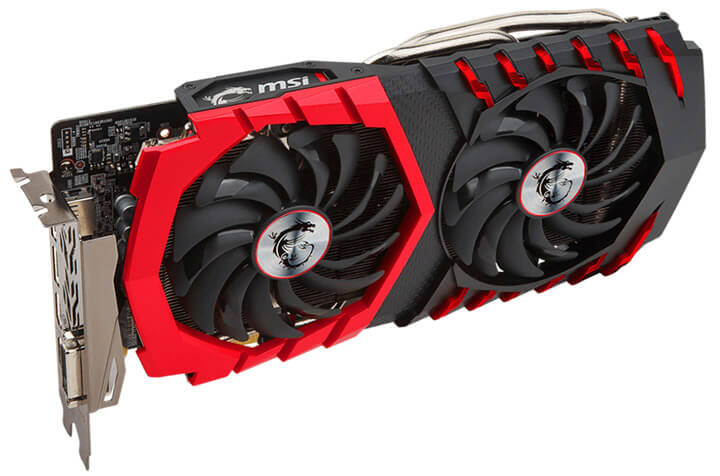
The low noise MSI RX 470 mining version was first released in Japan in 2021. MSI’s standard GPUs are also well adapted for mining, thanks to the dual-chamber air-cooled heatsinks. The video card is available in two versions with 4 GB and 8 GB of video memory.
Model specifications:
- Consumption – 130 W;
- Memory – 4 GB, 7000 MHz;
- Additional power supply – 8 pin;
- Power supply unit – 500 W.
Powercolor RX 470
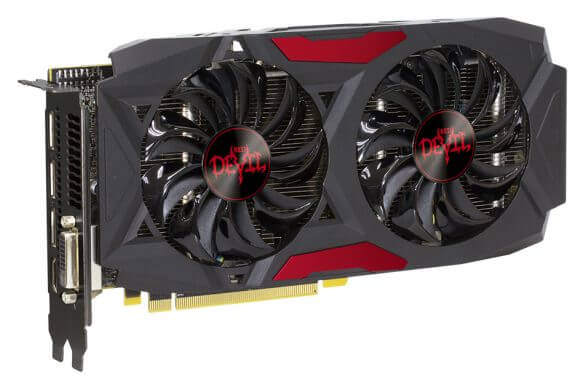
Mining is convenient on the Powercolor RX 470 video accelerator thanks to the dual BIOS / UEFI and the overclocking mode switch. The special profile of the cooler blades, and the nickel radiator grille with heat-dissipating pipes, guarantee protection against overheating at high loads.
Model specifications:
- Consumption – 120 W;
- Memory – 4 GB, 6600 MHz;
- Additional power supply – 8 pin;
- Power supply unit – 450 W.
Gigabyte RX 470
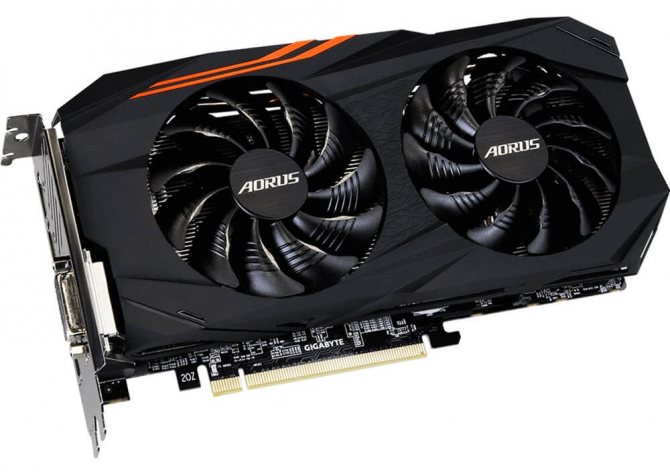
The gaming Gigabyte RX 470 is mined no worse than complex computer games. The proprietary XTREME Engine utility makes it easy to overclock the device to the desired parameters. Coolers WINDFORCE 2X provide effective heat dissipation, and color LED-backlight allows you to visually control the operation of the video card.
Model specifications:
- Consumption – 120 W;
- Additional power supply – 8 pin;
- Memory 4GB, 7000 MHz;
- Power supply unit – 450 W.
Asus RX 470
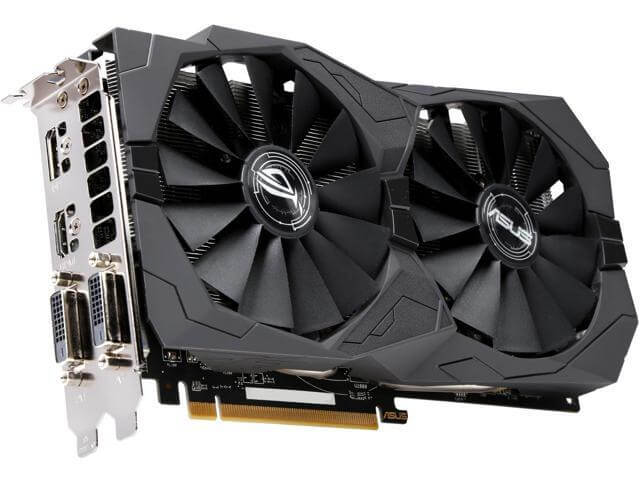
For Asus RX 470, mining is a native element. A video card with a samsung memory chip, released specifically for cryptocurrency mining. The video card quickly fails due to a poor cooling system, killers after 1 year of use stop spinning. We do not recommend buying such video cards for 24/7 mining.
Model specifications:
- Consumption – 120 W;
- Memory – 4GB, 7000 MHz;
- Additional power supply – 8 pin;
- Power supply unit – 450 W.
Sapphire RX 470
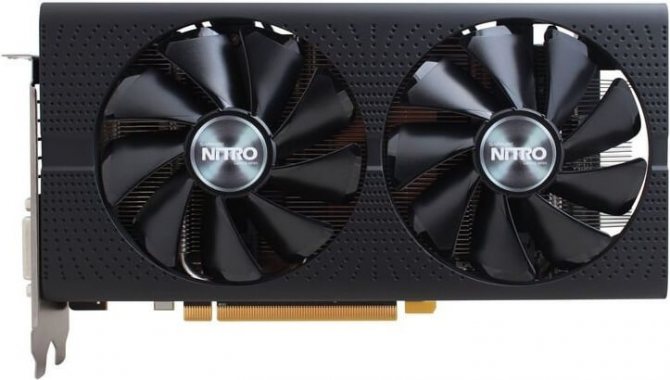
On the Sapphire RX 470 video card, mining will be as efficient as possible. The graphics processor is as powerful as the 480 model. Even with standard parameters, the RX 470 sapphire in mining demonstrates a high hash rate.
Model specifications:
- Consumption – 175 W;
- Memory – 8 GB , 8000 MHz;
- Additional power supply – 8 pin;
- Power supply unit – 500 W.
The power supply unit for the RX 470 mining farm is selected according to its power based on the amount of consumption of nodes (GPU, riser, motherboard, processor) with the addition of 20% to protect against overload.
Before buying a used video card, you should carefully inspect the product. First of all, attention is paid to such criteria.
- Sale date.
- Factory seals and stickers.
- The presence of swollen and chipped parts.
- PCB color. After the repair, the silk-screen printing darkens, the shade of the textolite changes.
- Degree of wear on coolers. The blades should be easy to scroll by hand, without extraneous sounds and backlash.
After an external examination, performance tests are carried out using special programs ( GPU-Z , FurMark , etc.).
Factory defect appears in the first months. If the RX 470 in mining has worked for a year without breakdowns, then, subject to careful operation, it will serve the new owner for a long time. But no one is safe from troubles, so it is better to purchase new GPUs for a mining farm.
Cooling system
The lightweight and relatively compact ASUS ROG Strix RX 470 OC is equipped with a DirectCU II cooling system.
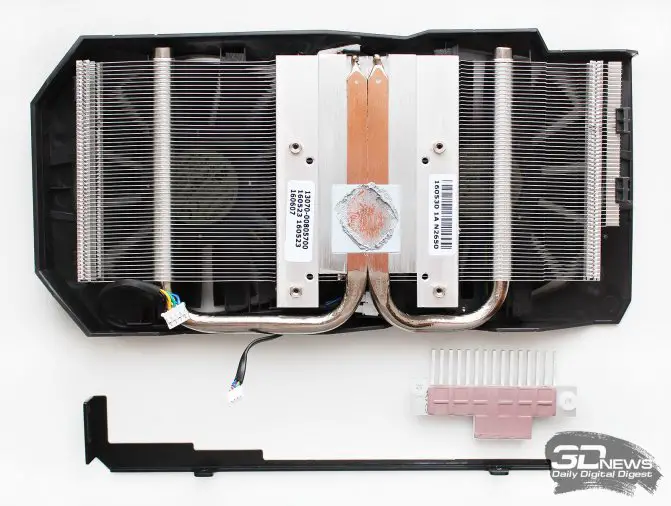
It is based on an aluminum radiator, from the base of which two copper nickel-plated heat pipes with a diameter of 6 mm emerge, then passing through the same radiator.
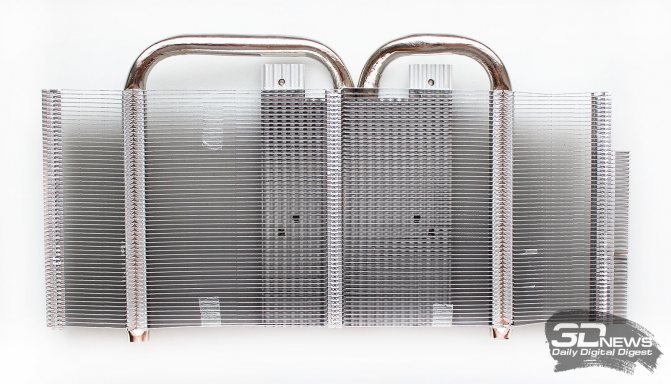
The base of the radiator is made using direct contact technology, that is, the tubes are part of it and are in direct contact with the GPU crystal. Despite the absence of a gap at the junction of the tubes, part of the GPU crystal is still in contact with the aluminum base of the heatsink, which is unlikely to have a positive effect on heat transfer.
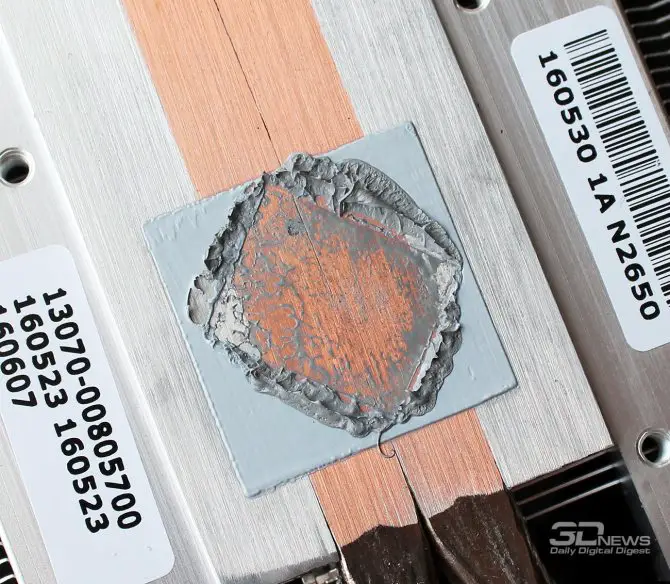
The heatsink and PCB are cooled by two fans with 96 mm impellers mounted on stands in a plastic frame.
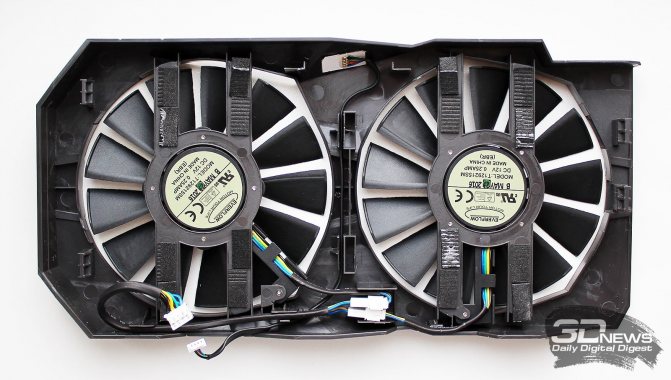
In this version of ASUS DirectCU II, fans with an optimized wing-blade profile are used, which have a wide end edge, thanks to which they are able to develop an increased static pressure and pump an increased volume of air flow.
Based on the markings on the stator, the manufacturer of these fans is Everflow (model T129215SM).
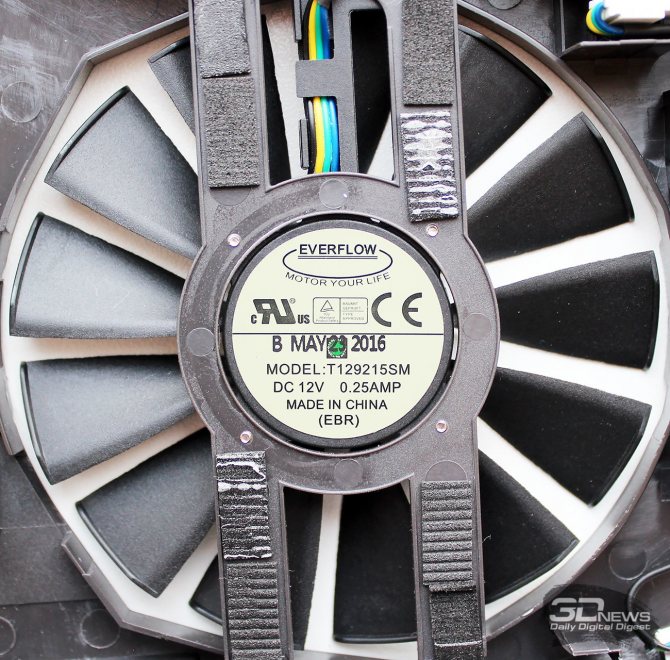
The fan speed is automatically controlled by pulse width modulation in the range from 0 to 2600 rpm. In 2D mode and at minimum 3D load, the fans do not spin at all, starting only when the GPU temperature reaches 55 degrees Celsius.
The cooling system has an illuminated logo (where can we go without it?), The color of which is adjustable using the Aura RGB app. There you can also choose one of six modes of its glow.
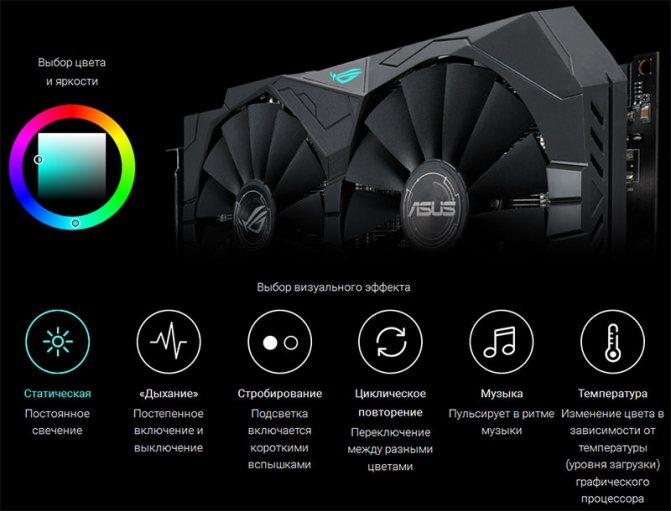
We used nineteen cycles of the Fire Strike Extreme stress test from the 3DMark package to test the temperature regime of the video card as a load.
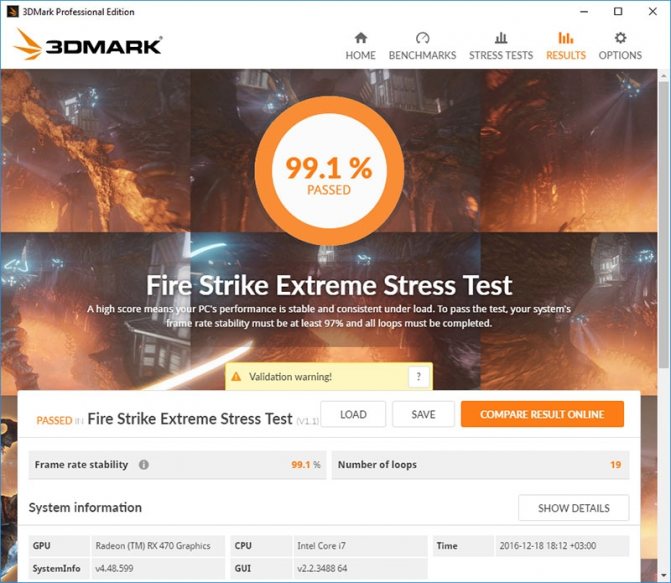
To monitor temperatures and all other parameters, the MSI Afterburner program version 4.3.0 was used, as well as the GPU-Z utility version 1.16.0. The tests were carried out in a closed case of the system unit, the configuration of which you can see in the next section of the article, at a room temperature of 23.9 ~ 24.4 degrees Celsius.
First of all, we checked the temperature mode of the video card with fully automatic fan speed control.
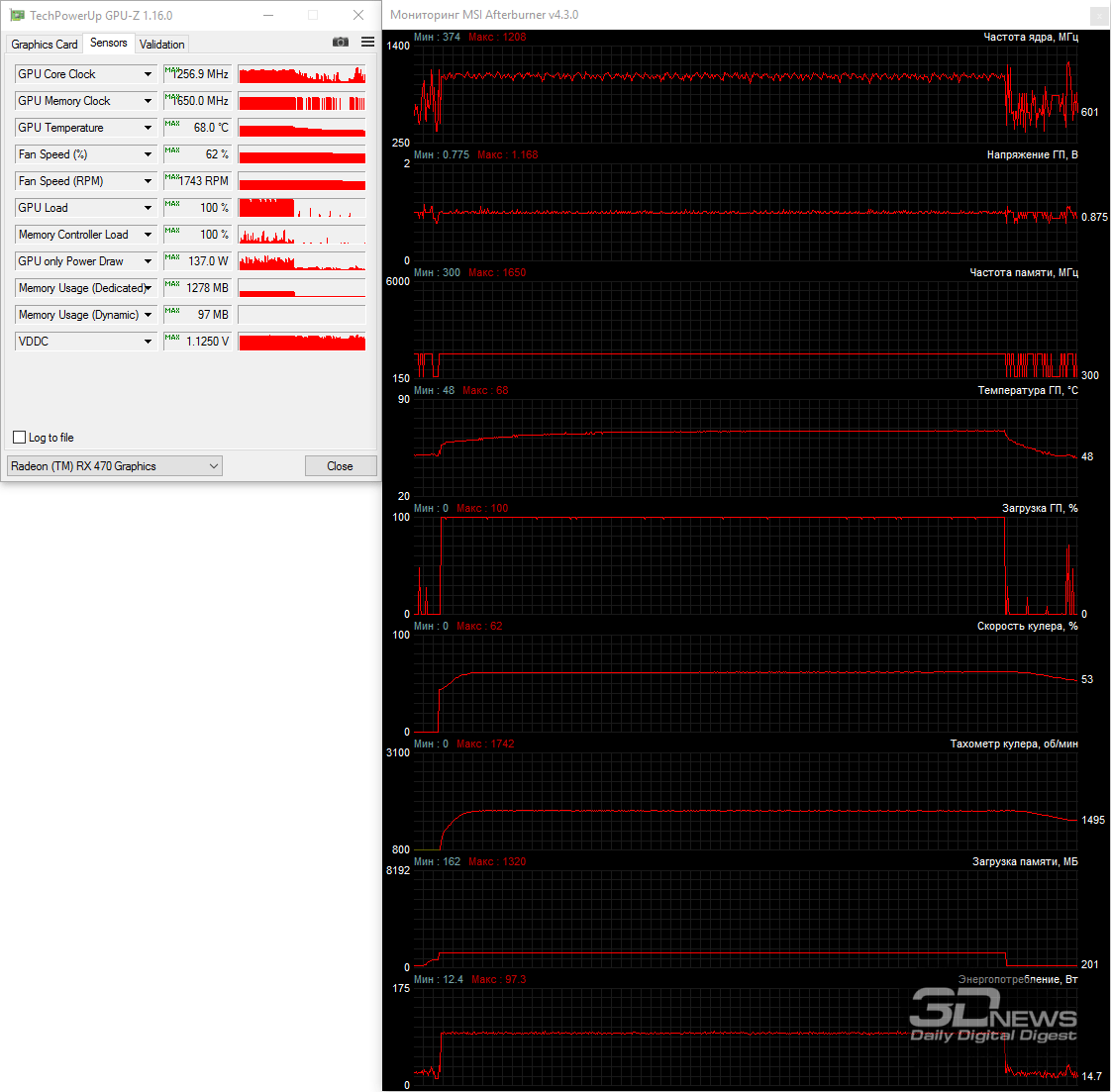
We have no complaints about the GPU temperature, which reached a modest 68 degrees Celsius during testing, as well as the fan speed, which increased only to 1740 rpm. But the stability of the frequency of the GPU leaves much to be desired. At its peak, it reaches 1208 MHz, but in practice it fluctuates in the range from 1100 to 1130 MHz – this is far from the 1250/1270 MHz graphics card declared in the specifications.
We cannot say that the video card is overheating, but perhaps it lacks the power limit? Let’s check this assumption: increase the Power Limit to the maximum (50%) and at the same time increase the cooling efficiency by setting the maximum rotational speed of the cooler fans. Here’s what came of it.
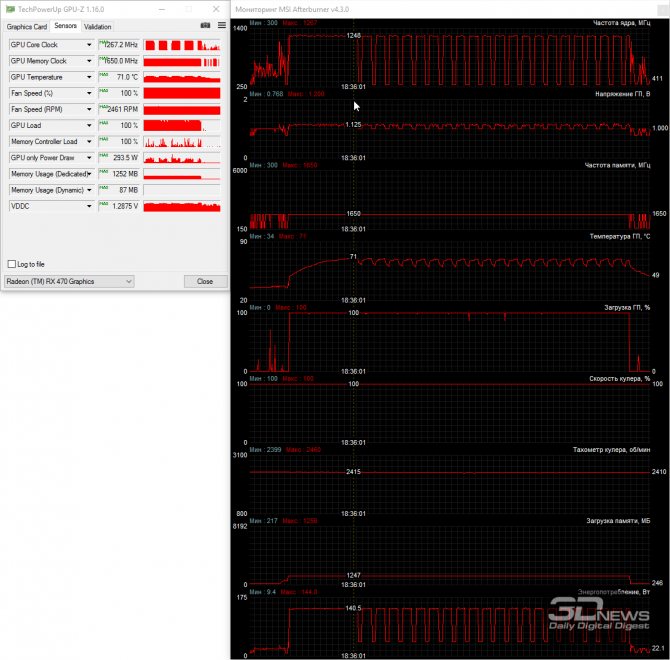
It turned out only worse, since the video card worked at 1250 MHz only for the first two or three cycles of the Fire Strike Extreme test, and then dropped the frequency and voltage, which led to obvious twitching of the image and a noticeable decrease in performance. Moreover, from time to time it did not even pass the 3DMark stability test.
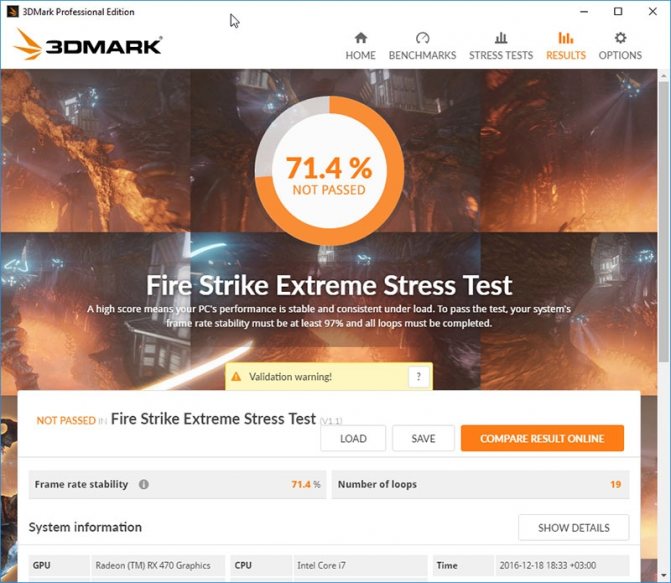
Through trial and error, as well as with the help of information found on the forums, we edited the BIOS of the ASUS ROG Strix RX 470 OC video card, raising its TDP limit from 95 to 175 watts, and also using MSI Afterburner, we increased the Power Limit by 22% and reduced the voltage on the core at 54 mV.
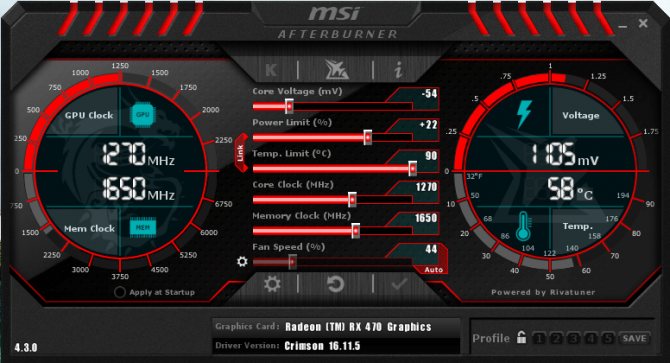
All this made it possible to achieve a more or less stable frequency at around 1215 MHz from the graphics processor of the ASUS video card, and at the same time it was possible to keep its temperature normal.
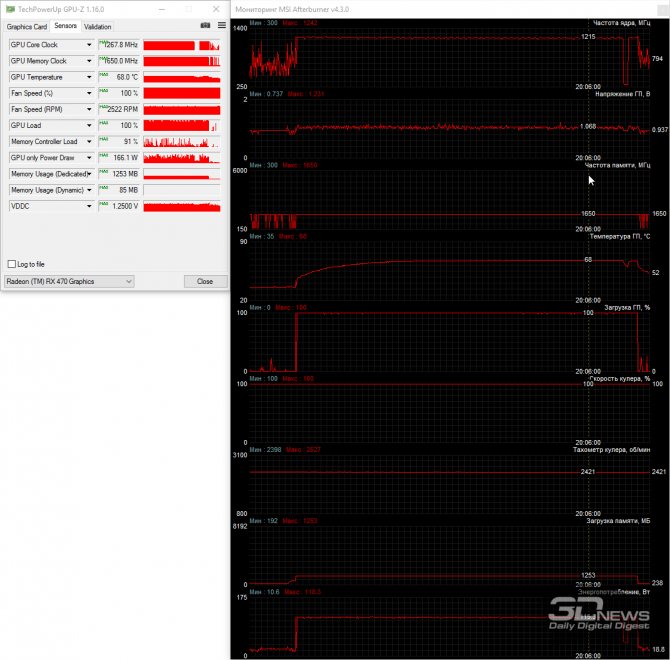
Of course, with such oddities in the nominal operating mode, there is simply no need to talk about overclocking the ASUS ROG Strix RX 470 OC, so let’s go straight to the test configuration, methodology and tests.
Dual mining, frequencies for the normal operation of the video card
In the new releases of PhoenixMiner, the developers have added support for the modified ETChash algorithm and ETH / ETC + Zill combined mining.
We set the frequency for the core 1169 and for the memory 2100, with these parameters the card consumes 95 W, Ethereum mining on the video card reaches 26 Mh / s and 450 per decred. Frequencies 1070/2100 reduce power consumption in mining to 70 W, with a hashrate of 25/430, this is the best option for setting up the GPU of a crypto farm.
On the coins of the EquihashZero platform (Vidulum and Zclassic (ZCL)), according to the calculator, the hashrate is not bad for mining, but there are very few pools for work and exchanges.
Often video cards during dual mining can melt 8 pin wires on the power supply. This is due to the colossal high voltage across the core. In order to avoid problems, set Core Voltage -100. Detailed settings for dual mining.
Test configuration, tools and testing methodology
Performance testing of video cards was carried out in a closed case on a system with the following configuration:
- motherboard: ASUS X99-A II (Intel X99 Express, LGA2011-v3, BIOS 1201 dated 10/11/2016);
- central processor: Intel Core i7-6900K (14 nm, Broadwell-E, R0, 3.2 GHz, 1.1 V, 8 × 256 KB L2, 20 MB L3);
- CPU cooling system: Phanteks PH-TC14PЕ (2 Corsair AF140, ~ 900 rpm);
- thermal interface: ARCTIC MX-4 (thermal conductivity 8.5 W / (m · K);
- RAM: DDR4 4 × 4 GB Corsair Vengeance LPX 2800 MHz (CMK16GX4M4A2800C16) (XMP 2800 MHz / 16-18-18-36_2T / 1.2 V or 3000 MHz / 16-18-18-36_2T / 1.35 V) ;
- video cards: NVIDIA GeForce GTX 1060 Founders Edition 6 GB 1506-1709 (1886) / 8008 MHz;
- ASUS ROG Strix RX 470 OC 4 GB 1250-1270 / 6600 MHz (in standard mode and after software modification);
- MSI Radeon R9 280X Gaming 3 GB 1050/6000 MHz;
- disk for system and games: Intel SSD 730 480GB (SATA-III, BIOS vL2010400);
- benchmark disk: Western Digital VelociRaptor (SATA-II, 300 GB, 10,000 rpm, 16 MB, NCQ);
- archive disk: Samsung Ecogreen F4 HD204UI (SATA-II, 2 TB, 5400 rpm, 32 MB, NCQ);
- sound card: Auzen X-Fi HomeTheater HD;
- case: Thermaltake Core X71 (four be quiet! Silent Wings 2 (BL063) at 900 rpm);
- control and monitoring panel: Zalman ZM-MFC3;
- PSU: Corsair AX1500i Digital ATX (1500 W, 80 Plus Titanium), 140 mm fan;
- monitor: 27-inch Samsung S27A850D (DVI, 2560 × 1440, 60 Hz).
We will compare the ASUS ROG Strix RX 470 OC with the reference version of the NVIDIA GeForce GTX 1060 Founders Edition and the original MSI Radeon R9 280X Gaming at nominal frequencies.
We do not currently have a version of the GeForce GTX 1060 with 3 GB of memory, which is a direct competitor to the Radeon RX 470, but in the next articles we hope to correct this omission. We add that in the GeForce drivers, the priority was set to maximum performance, and for the MSI video card, they were increased to the maximum possible limits for power and temperature.
To reduce the dependence of the performance of video cards on the platform speed, a 14-nm eight-core processor with a multiplier of 40, a reference frequency of 100 MHz and the Load-Line Calibration function activated to the third level was overclocked to 4.0 GHz when the voltage in the motherboard BIOS was raised to 1.2095 V …
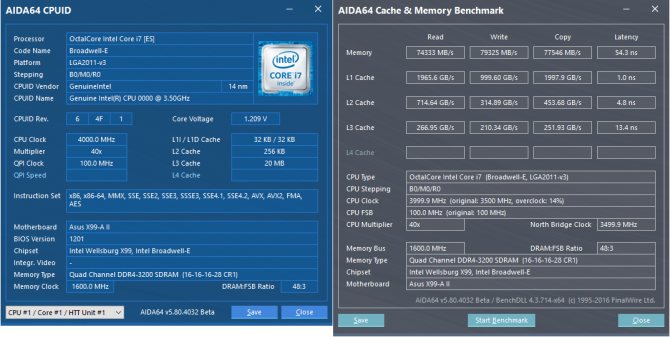
In this case, 16 gigabytes of RAM operated at a frequency of 3.2 GHz with timings of 16 -16-16-28 CR 1 at a voltage of 1.35 V. Testing commenced December 17, 2021, was conducted under Microsoft Windows 10 Professional operating system with all updates on the specified date and with the installation of the following drivers:
- motherboard chipset Intel Chipset Drivers – 10.1.1.38 WHQL dated 12/10/2016;
- Intel Management Engine Interface (MEI) – 11.6.0.1039 WHQL от 14.12.2016;
- drivers for video cards on NVIDIA graphics processors – GeForce 376.33 WHQL dated 12/14/2016;
- video card drivers on an AMD graphics processor – AMD Radeon Crimson 16.11.5 dated 11/28/2016.
We did not use the AMD Radeon Crimson ReLive 16.12.1 drivers already available at the time of this article preparation, since there were much more negative reviews than positive ones, and no performance gain was found in practice. It is not surprising that the version of ReLive 16.12.2, released after the completion of the tests, contained a rather extensive list of fixes and improvements, but it will be used in the next article.
Due to the low performance of the video cards tested today, they were tested only in one resolution – 1920 × 1080 pixels. Two graphics quality modes were used for the tests: Quality + AF16x – texture quality in the drivers by default with anisotropic filtering at 16x and Quality + AF16x + MSAA 4x with anisotropic filtering at 16x and full-screen anti-aliasing at 4x, in cases where the average number of frames per second remained high enough for comfortable play. In some games, due to the specifics of their game engines, other anti-aliasing algorithms were used, which will be indicated later in the methodology and in the diagrams. Anisotropic filtering and full-screen anti-aliasing was enabled directly in the game settings. If these settings were missing in the games, then the parameters were changed in the control panel of the GeForce or Crimson drivers. V-Sync was also forcibly disabled there. Apart from the above, no additional changes were made to the driver settings.
The graphics cards were tested in one graphics test, one VR benchmark and fourteen games, updated to the latest versions as of the date of publication. Compared to my previous test of video cards, the list of test applications has undergone noticeable changes. It removed the rather outdated and not too resource-intensive Battlefield 4, Thief and Sniper Elite III, but included three new games with DirectX 12 support: Total War: WARHAMMER, Gears of War 4 and Sid Meier’s Civilization VI. So now the list looks like this (games and further test results in them are arranged in the order of their official release):
- 3 DMark (DirectX 11/12) – version 2.2.3509, tested in the scenes Fire Strike, Fire Strike Extreme, Fire Strike Ultra and Time Spy (the charts now show the score for the graphics, not the total);
- Crysis 3 (DirectX 11) – version 1.3.0.0, all graphics quality settings to maximum, the degree of blur is medium, reflections are on, modes with FXAA and with MSAA 4x, double consecutive pass of a scripted scene from the beginning of the Swamp mission lasting 105 seconds;
- Metro : Last Light (DirectX 11) – version 1.0.0.15, the built-in game test was used, graphics quality settings and tessellation at the Very High level, Advanced PhysX technology was disabled, tests with SSAA and without anti-aliasing, double sequential run of the D6 scene;
- Grand Theft Auto V (DirectX 11) – build 877, quality settings at Very High, ignoring suggested restrictions enabled, V-Sync disabled, FXAA enabled, NVIDIA TXAA disabled, MSAA for reflections disabled, NVIDIA soft shadows;
- DiRT Rally (DirectX 11) – version 1.22, we used the built-in test on the Okutama track, graphics quality settings to the maximum level for all points, Advanced Blending – On; tests with MSAA 8x and without anti-aliasing;
- Batman : Arkham Knight (DirectX 11) – version 1.6.2.0, quality settings at High, Texture Resolutioin normal, Anti-Aliasing on, V-Sync disabled, tests in two modes – with and without activation of the last two NVIDIA GameWorks options, double sequential run of the test built into the game;
- Tom Clancy ‘ s the Rainbow Six : Siege (of DirectX 11) – version 5.2, setting quality textures at Very High, Texture Filtering – Anisotropic 16X and other maximum quality settings, tests with MSAA 4x and without smoothing, two consecutive run the built-in test game ;
- Rise of the Tomb Raider (DirectX 12) – version 1.0 build 753.2_64, all parameters at the Very High level, Dynamic Foliage – High, Ambient Occlusion – HBAO +, tessellation and other quality improvement techniques are activated, two test cycles of the built-in benchmark (Geothermal scene Valley) without anti-aliasing and with SSAA 4.0 activation;
- Far Cry Primal (DirectX 11) – version 1.3.3, maximum quality level, high-resolution textures, volumetric fog and shadows to maximum, built-in performance test without anti-aliasing and with SMAA activation;
- Tom Clancy ‘ s The Division (DirectX 11) – version 1.5, maximum quality level, all picture enhancement parameters are activated, Temporal AA – Supersampling, testing modes without anti-aliasing and with SMAA 1X Ultra activation, built-in performance test, but fixing FRAPS results;
- Hitman (DirectX 12) – version 1.8.0, built-in test with graphics quality settings at the “Ultra” level, SSAO enabled, shadow quality “Ultra”, memory protection disabled;
- Deus Ex : Mankind Divided (DirectX 12) – version 1.12 build 667.0, all quality settings are manually set to the maximum level, tessellation and depth of field are activated, at least two consecutive runs of the benchmark built into the game;
- Total War : WARHAMMER (DirectX 12) – version 1.5.0 build 12745.988912, all graphics quality settings to the maximum level, reflections enabled, unlimited video memory and SSAO enabled, double sequential run of the benchmark built into the game;
- Gears of War 4 (DirectX 12) – version 9.4.0.2, quality settings at Ultra, V-Sync disabled, all effects enabled, double sequential run of the benchmark built into the game;
- Sid Meier ‘ s Civilization VI of (of DirectX 12) – version 1.0.0.38, maximum graphics quality, frame restriction off, high-resolution textures are activated, dynamic lighting, shadows, 8192 × 8192, two consecutive run in-game benchmark.
If the games implemented the ability to fix the minimum number of frames per second, then it was also reflected in the diagrams. Each test was carried out twice, the best of the two obtained values was taken as the final result, but only if the difference between them did not exceed 1%. If the deviations of the test runs exceeded 1%, then the testing was repeated at least one more time in order to obtain a reliable result.
Performance test results
In the diagrams, the results of testing a video card on an NVIDIA GPU are highlighted in green , and on AMD GPUs, they are reflected in a red color scheme typical for this manufacturer . To highlight the performance of the software-modified ASUS ROG Strix RX 470 OC, we chose a purple fill color. Let us add that on the diagrams in each quality mode, the test results are sorted from top to bottom in descending order of the cost of video cards.

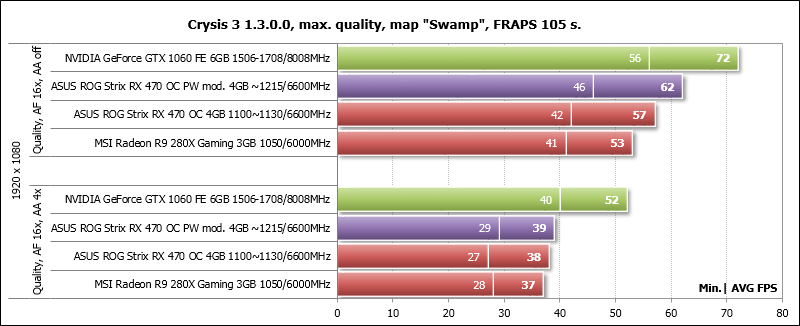
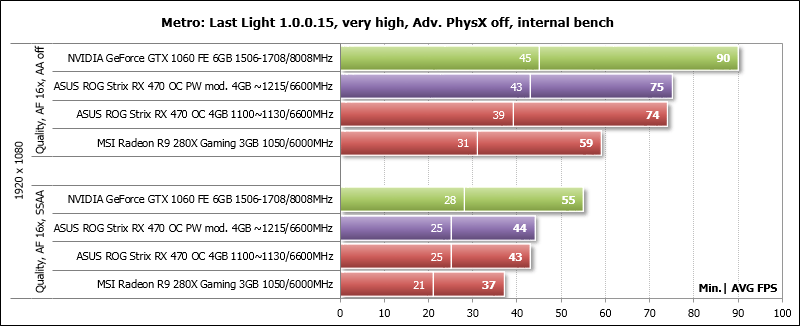
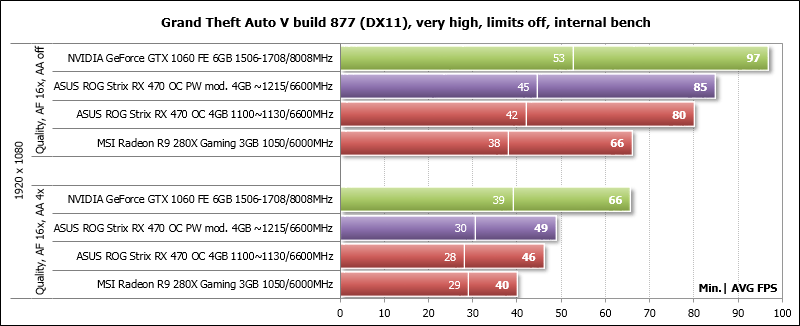
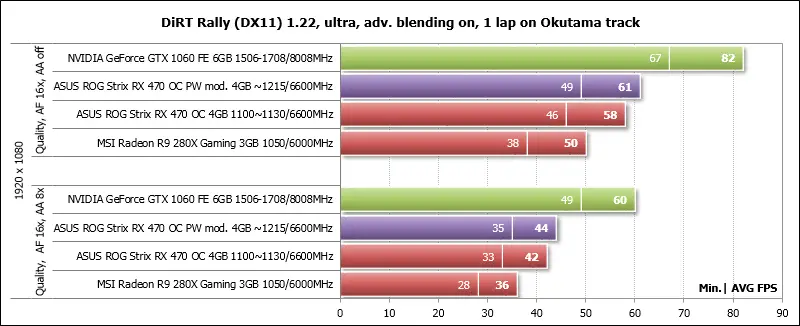
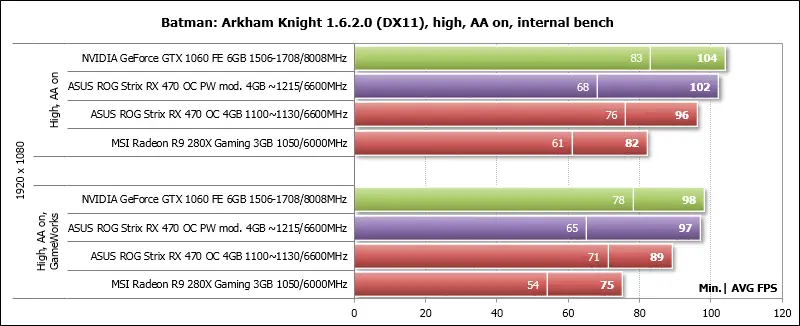

- Tom Clancy’s Rainbow Six: Siege
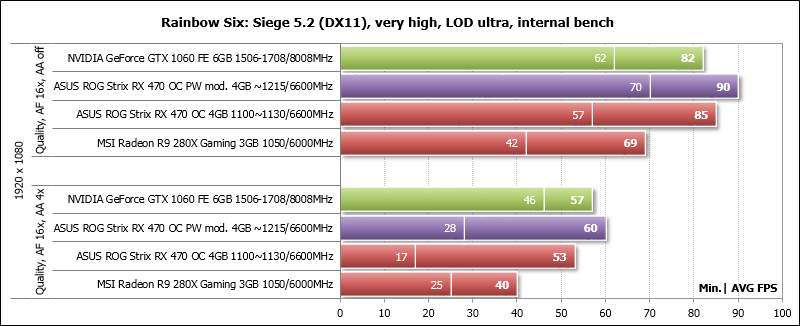
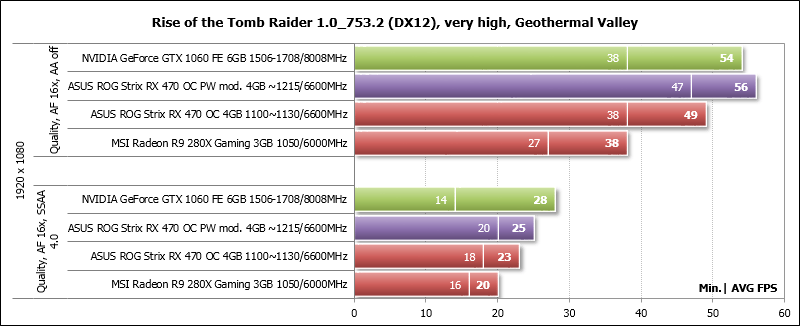
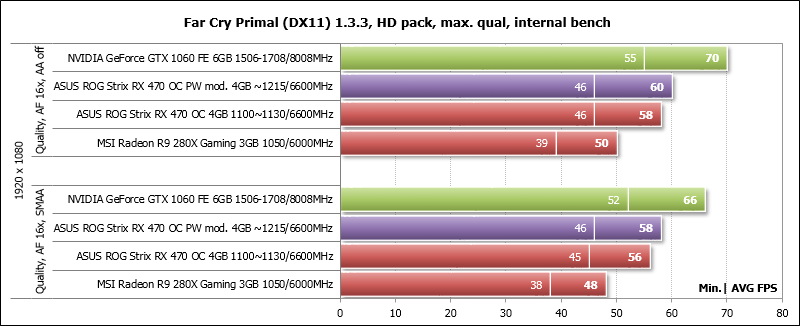
- Tom Clancy’s The Division
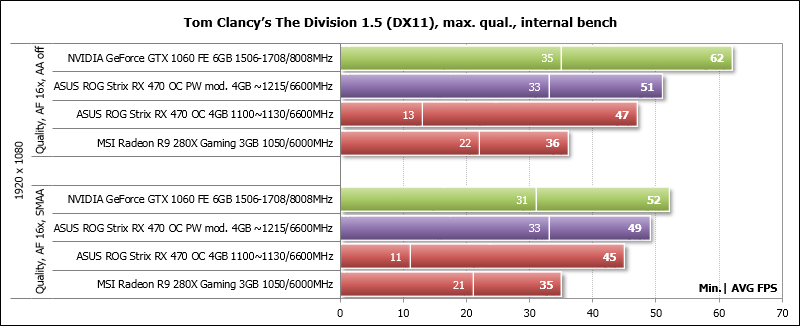
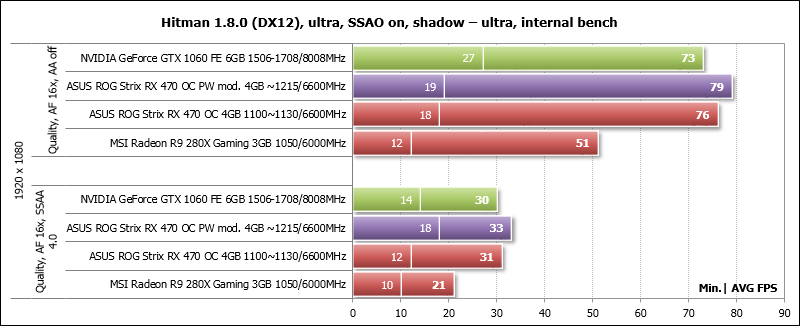
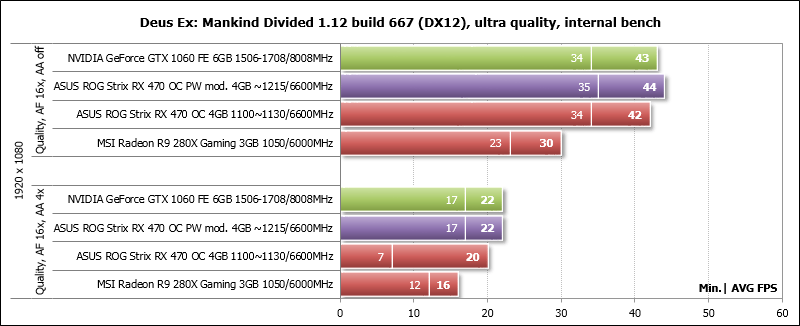
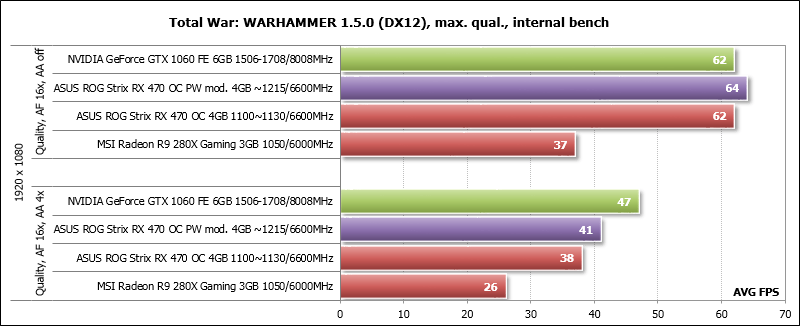
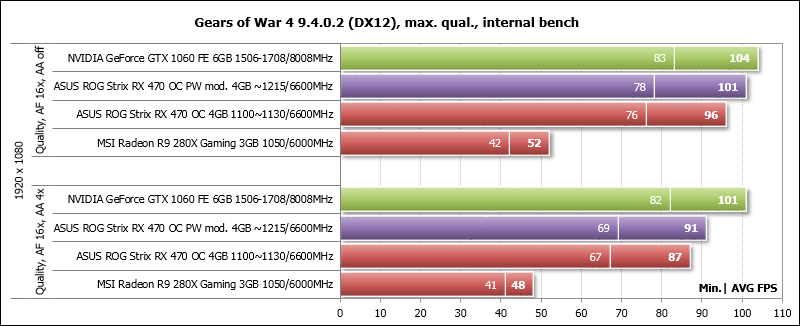
- Sid Meier’s Civilization VI
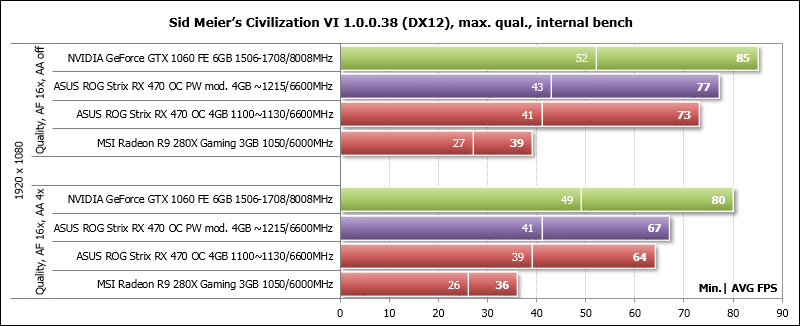
Let’s supplement the constructed diagrams with a summary table with test results with the displayed average and minimum value of the number of frames per second for each video card.
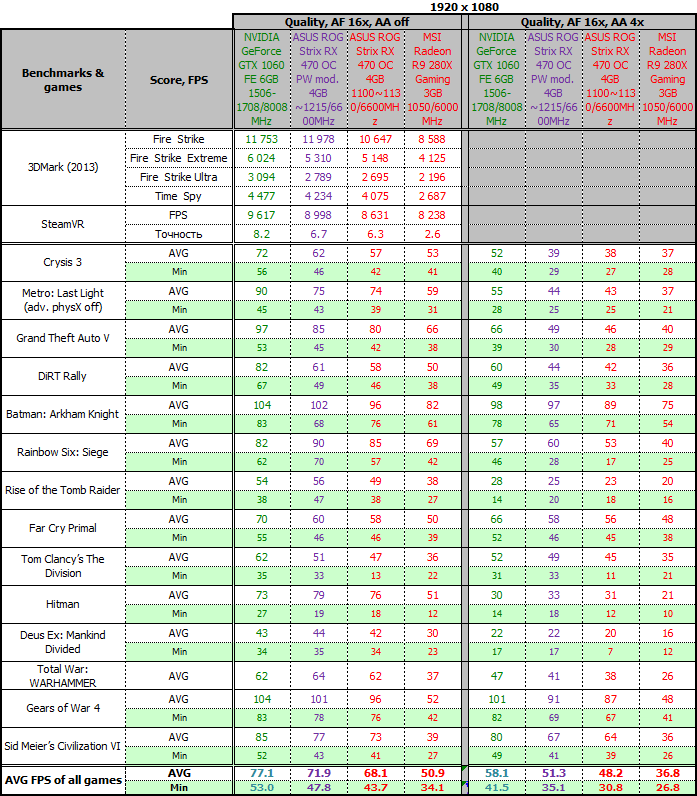
We will analyze the results using the summary diagrams in the next section of the article.
⇡ # Pivot charts and their analysis
First of all, we propose to analyze what performance gain is brought by software optimization of the ASUS ROG Strix RX 470 OC graphics processor: by manipulating the BIOS, we managed to stabilize the frequency in 3D mode by about 1215 MHz against the previous 1110-1130 MHz. This is still lower than the level announced by ASUS, but at least something.
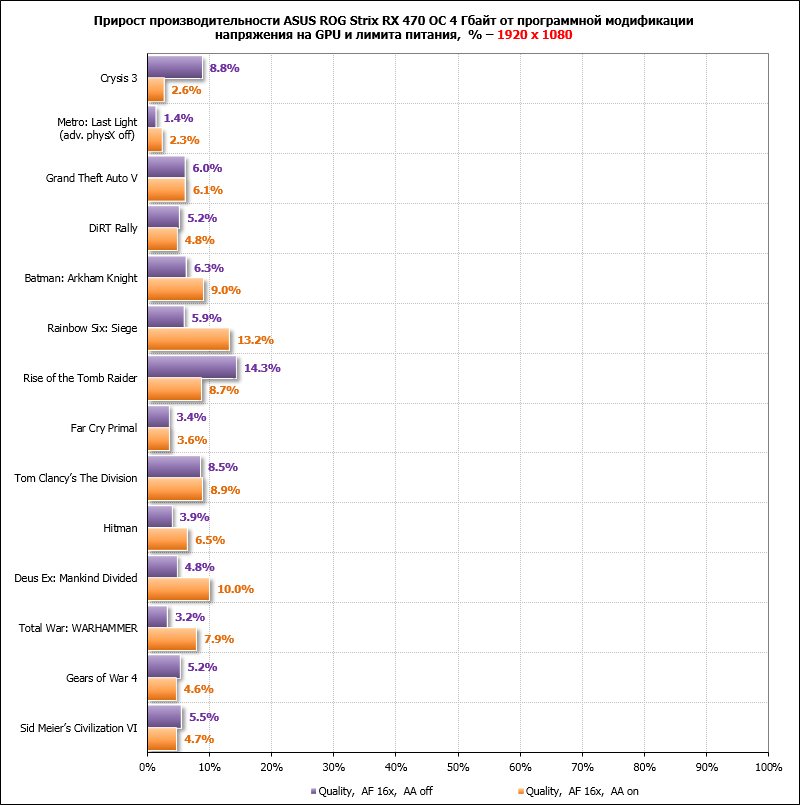
On average, for all gaming tests, the performance gain was 5.9-6.6%, which, albeit a little, but actually free. However, in our opinion, the most important effect of such an upgrade is a decrease in the number of performance drops when the GPU frequency drops very much, which immediately affects the minimum FPS and gaming comfort. It is almost impossible to reflect this in numerical values (it can be clearly seen only in The Division and Rainbow Six), but according to the real feelings in games it is simply impossible not to notice.
Now let’s compare the software-optimized ASUS ROG Strix RX 470 OC with the reference NVIDIA GeForce GTX 1060 at nominal frequencies. Let’s remind: this is not overclocking, this is an attempt to get from the video card what the manufacturer promised.
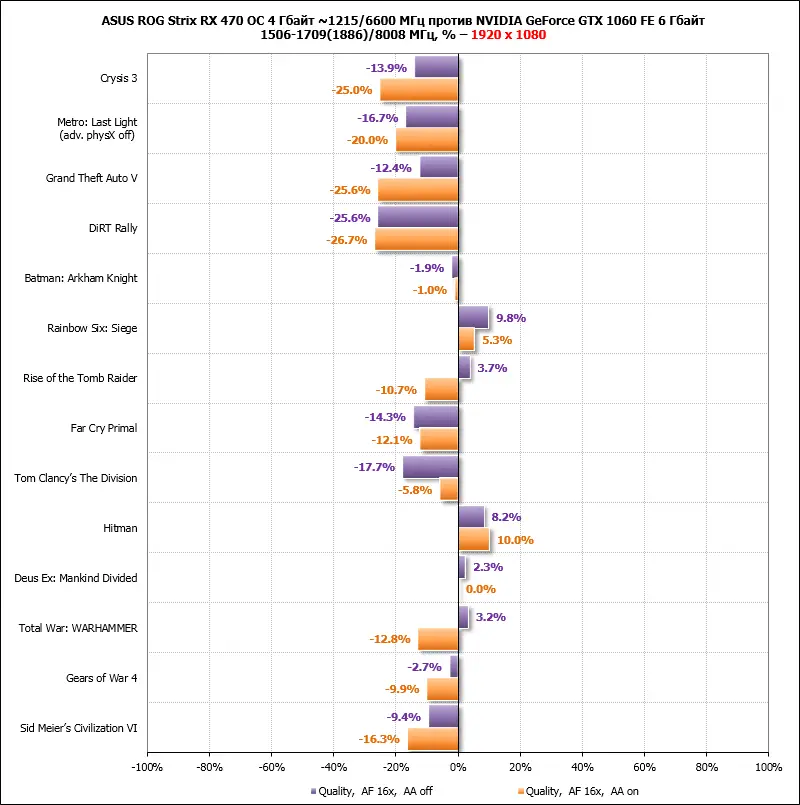
ASUS ROG Strix RX 470 OC managed to win in Rainbow Six: Siege and Hitman, in separate modes Rise of the Tomb Raider and Total War: WARHAMMER, as well as not to lose in Batman: Arkham Knight. In other games, the reference NVIDIA GeForce GTX 1060 6 GB is faster, and the original models of this video card with increased frequencies will be 6-8% faster. For the sake of fairness, we recall that the market average cost of the GeForce GTX 1060 6 GB is slightly higher than the price of the Radeon RX 470 4 GB.
The third and final pivot chart will be the performance comparison of the ASUS ROG Strix RX 470 OC and the MSI Radeon R9 280X Gaming. Of course, now these are products of different price categories, but three years ago AMD Radeon R9 280X, the successor of the even more ancient AMD Radeon HD 7970 GHz Edition, came out at a price of $ 299, and AMD Radeon RX 470 presented this summer was recommended for sale for only $ 179 (with 4GB memory). Therefore, this summary chart is interesting from the point of view of assessing progress in middle-class video cards.
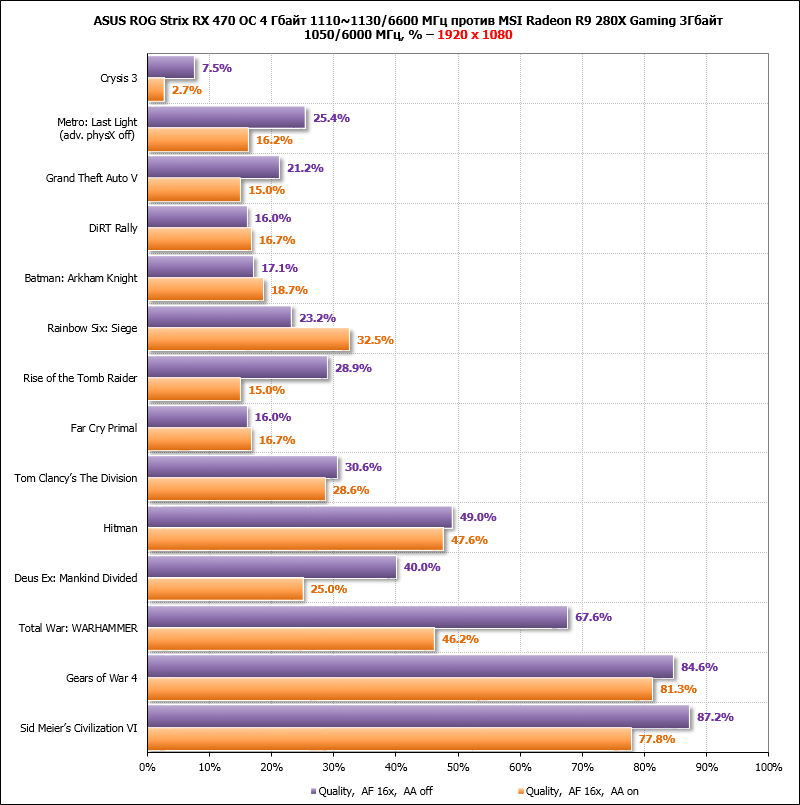
Frankly, for the three-year difference between video cards, the gain is not very convincing, although in the newest games requiring video memory, ASUS ROG Strix RX 470 OC is almost twice as fast as the original Radeon R9 280X.
Power consumption
The energy consumption was measured using a Corsair AX1500i power supply via the Corsair Link interface and the monitoring program of the same name, version 4.3.0.154. The energy consumption of the entire system as a whole was measured without taking into account the monitor. The measurement was carried out in 2D mode during normal work in Microsoft Word or Internet surfing, as well as in 3D mode. In the latter case, the load was created using four consecutive cycles of the Swamp-level introductory scene from Crysis 3 at 2560 × 1440 pixels at maximum graphics quality settings and using MSAA 4X.
Let’s compare the level of power consumption of systems with the video cards tested today according to the diagram.

The configurations with AMD graphics cards are still far from the level of economy of the system with the reference GeForce GTX 1060, but it is pleasant to note that our software modification of the ASUS video card allowed not only to increase performance, but also to make the video card more economical. In addition, there is a higher energy efficiency of video cards with the Polaris 10 core versus video cards with previous generations of GPUs.
How to Increase: Overclocking Radeon RX 470 4 and 8 GB
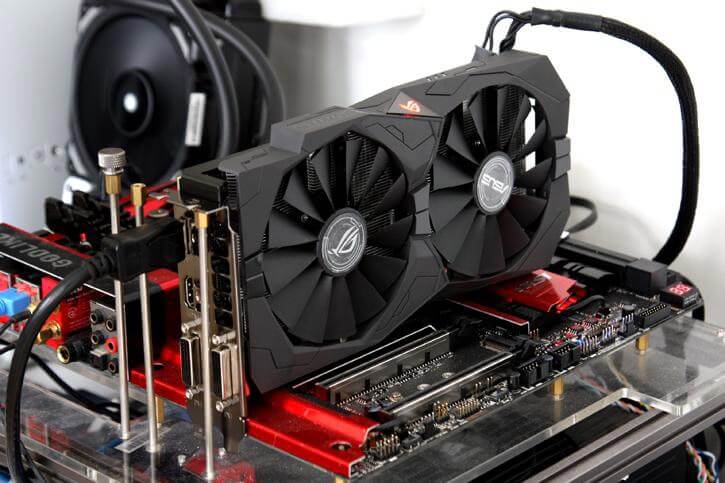
In addition to modifying the BIOS, you need to speed up your work. In this section, you will learn: “How to overclock a video card for mining.” Requires MSI Afterburner to be installed to adjust:
- Frequencies core (Core Clock).
- Memory frequency (Memory Clock).
- Power limit (Power Limit).
- Voltages core (Core Voltage).
- Mode coolers speed (Fan Speed).
Exceeding the optimum permissible frequencies leads to malfunctions. To determine the correct overclocking settings for the video card.
- We recommend overclocking the video card by gradually adding +30 MHz. When mining ETH, the core frequency is practically not used, therefore the optimal value is 1169 MHz. , but for the memory frequency, you need to set the maximum effective values of about 2100 MHz .
- You can also overclock cards using mining programs. Enter the necessary parameters –cclock and –mclock in the Claymore’s or Phoenix batch file and the miner will do everything himself. But these options do not always work correctly, so watch the miner window at startup.





